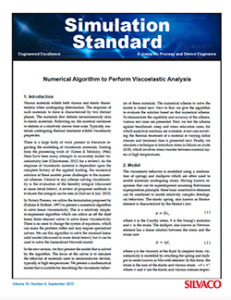Numerical Algorithm to Perform Viscoelastic Analysis
Introduction
 Viscous materials exhibit both viscous and elastic characteristics when undergoing deformation. The response of such materials to force is characterized by two distinct phases. The materials first deform instantaneously akin to elastic materials. Following on, the material continues to deform at a relatively slower time scale. Typically, materials undergoing thermal treatment exhibit viscoelastic properties.
Viscous materials exhibit both viscous and elastic characteristics when undergoing deformation. The response of such materials to force is characterized by two distinct phases. The materials first deform instantaneously akin to elastic materials. Following on, the material continues to deform at a relatively slower time scale. Typically, materials undergoing thermal treatment exhibit viscoelastic properties.
There is a large body of work present in literature regarding the modelling of viscoelastic materials. Starting from the pioneering work of (Green & Tobolsky, 1946), there have been many attempts to accurately model viscoelasticity (see (Christensen, 2012) for a review). As the response of viscoelastic material is dependent upon the complete history of the applied loading, the numerical solution of these models poses challenges to the numerical schemes. Central to any scheme solving viscoelasticity is the evaluation of the heredity integral (discussed in more detail below). A review of proposed methods to evaluate this integral can be seen in (Sorvari & Jari, 2010).
In Victory Process, we utilize the formulation proposed by (Kaliske & Rothert, 1997) to present a numerical algorithm to solve linear viscoelasticity. This is a relatively simple-to-implement algorithm which can utilize an off the shelf linear finite element solver to solve linear viscoelasticity. There is no need to change the system of equations, which can make the problem stiffer and may require specialized solvers. We use this algorithm to solve the standard linear solid model (discussed in more detail below), but it can be used to solve the Generalized Maxwell model.
In the next section, we first present the model that is solved by the algorithm. The focus of the solver is to simulate the behavior of materials used in semiconductor devices, typically at high temperatures. We present a mathematical model that is suitable for describing the viscoelastic behavior of these materials. The numerical scheme to solve the model is stated next. Next to that, we give the algorithm to evaluate the solution based on that numerical scheme. To demonstrate the capability and accuracy of the scheme, various test cases are presented. First, we test the scheme against benchmark creep and stress relaxation cases, for which analytical solutions are available. A test case involving the thermal treatment of a material at varying initial stresses and treatment time is presented next. Finally, we simulate a technique to introduce stress in Silicon on oxide (SOI), which involves stress transfer between material layers at high temperatures.



